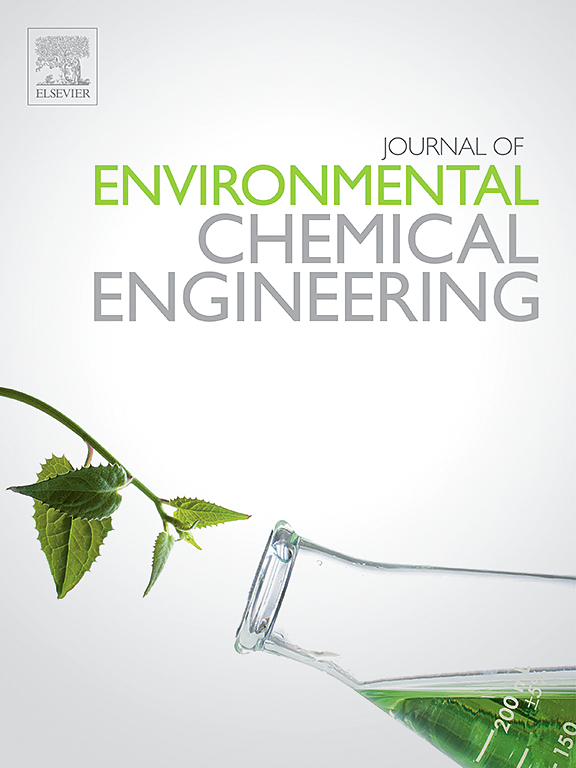增强铂簇修饰碳氮化物去除铀(VI)的可见光光催化活性
IF 7.4
2区 工程技术
Q1 ENGINEERING, CHEMICAL
引用次数: 0
摘要
近年来,光催化技术因其环保、高效等优点而被视为去除放射性废水中 U(VI)的有效方法之一。本研究在氯化锌熔盐中合成了铂簇修饰的氮化碳光催化剂(Pt-CN)。通过 XRD、IR、XPS、UV-vis、PL 和 EIS 对光催化剂进行了表征。结果表明,与块状氮化石墨碳(g-C3N4)相比,掺杂铂使 Pt-CN 显示出更高的电子传导性和更好的电荷分离与迁移,从而提高了光催化活性和更快的动力学速度。此外,对于含铀溶液的光催化处理,在 Xe 光照射 300 分钟后,Pt-CN 的去除率达到 94.6%,与 g-C3N4 相比,动力学性能提高了三倍。此外,Pt-CN 的良好重复利用率和光稳定性也得到了证实,即使经过五次回收和重复利用,其去除效率仍保持在 83.7%。光催化反应产物的特征为 (UO2)O2-2 H2O,其机理推断为铀物种与光照在开放系统中产生的 H2O2 发生反应。这种熔盐一步合成和掺杂铂的方法以及在空气中萃取铀(VI)的性能表明,Pt-CN 在水中萃取和去除铀(VI)方面的应用前景广阔。本文章由计算机程序翻译,如有差异,请以英文原文为准。
Enhanced visible light photocatalytic activity of Pt cluster modified carbon nitrides for U(VI) removal
Photocatalysis has been regarded as one of the effective methods of removing U(VI) from radioactive wastewater in recent years, due to the benefits of being environmentally friendly and efficient. In this work, a Pt cluster modified carbon nitride photocatalyst (Pt-CN) was synthesized in zinc chloride molten salt. The photocatalysts were characterized by XRD, IR, XPS, UV–vis, PL and EIS. The result demonstrated that the doping of Pt makes Pt-CN show higher electronic conductivity and better charge separation and migration, leading to an enhanced photocatalytic activity and faster kinetics compared with bulk graphitic carbon nitride (g-C3N4). Moreover, for uranium contained solution photocatalytic treatment, Pt-CN reached 94.6 % removal efficiency after 300 min of illumination with Xe light, and the kinetics improved by a factor of three compared to that of g-C3N4. Furthermore, the good reusability and photostability of the Pt-CN was confirmed as the removal efficiency remained at 83.7 % even after being recycled and reused five times. The photocatalytic reaction product was characterized as (UO2)O2·2 H2O, and the mechanism was deduced as uranium species reacting with H2O2 generated by light illumination in an open system. This molten salt one-step synthesis and Pt doping method and the performance of U(VI) extraction in air showed a promising potential for the application of Pt-CN for U(VI) extraction and removal from water.
求助全文
通过发布文献求助,成功后即可免费获取论文全文。
去求助
来源期刊

Journal of Environmental Chemical Engineering
Environmental Science-Pollution
CiteScore
11.40
自引率
6.50%
发文量
2017
审稿时长
27 days
期刊介绍:
The Journal of Environmental Chemical Engineering (JECE) serves as a platform for the dissemination of original and innovative research focusing on the advancement of environmentally-friendly, sustainable technologies. JECE emphasizes the transition towards a carbon-neutral circular economy and a self-sufficient bio-based economy. Topics covered include soil, water, wastewater, and air decontamination; pollution monitoring, prevention, and control; advanced analytics, sensors, impact and risk assessment methodologies in environmental chemical engineering; resource recovery (water, nutrients, materials, energy); industrial ecology; valorization of waste streams; waste management (including e-waste); climate-water-energy-food nexus; novel materials for environmental, chemical, and energy applications; sustainability and environmental safety; water digitalization, water data science, and machine learning; process integration and intensification; recent developments in green chemistry for synthesis, catalysis, and energy; and original research on contaminants of emerging concern, persistent chemicals, and priority substances, including microplastics, nanoplastics, nanomaterials, micropollutants, antimicrobial resistance genes, and emerging pathogens (viruses, bacteria, parasites) of environmental significance.
 求助内容:
求助内容: 应助结果提醒方式:
应助结果提醒方式:


